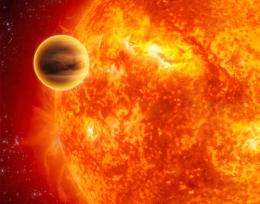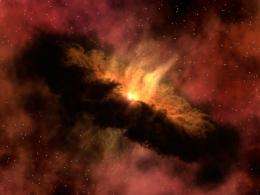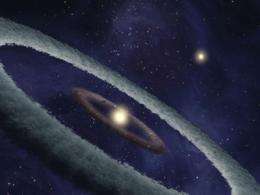Recipes for Renegade Planets

Recent discoveries of gas giant planets in unusual orbits challenge the generally accepted theory of planet formation. While these discoveries do not disprove the theory, they have opened our eyes to chaotic solar systems quite unlike our own.
Over the past two hundred years, a standard model emerged to explain how solar systems form. Using our own solar system as a guide, the model explains the existence of a central star (our Sun), an inner system of rocky, “terrestrial” planets, and an outer system of “gas giant” planets, all orbiting in nearly the same plane of rotation as the central star.
Recent discoveries of planetary systems around other stars have challenged this model. These exoplanet discoveries have included gas giant planets in close orbit around their stars, some of which are in radically different planes of rotation from their primary stars.
Deviation from the Model
In the generally accepted model for solar system formation, everything begins with a nebula (or cloud) containing gas and dust. Gravitational attraction causes the cloud to collapse, and if the collapse is less than perfectly symmetric, angular momentum will lead the cloud to form a nearly flat rotating disk.
The greatest concentration of material collects at the center of the disk, forming a protostar, while protoplanets may form at some distance from the center around areas of higher than average density within the disk. When the protostar eventually collects enough matter, fusion reactions begin and it becomes a young star, heating the inner portion of the disk and vaporizing any gases that may have collected - which naturally explains why planets that form near the star are rocky. At greater distances, gases can remain in icy form and accrete into gas giant planets. The limiting radius that defines the division between the rocky inner planets and outer gas giants is called the “ice line”.
Whether inside or outside the ice line, planets sweep out material within a particular radius of the disk as they orbit the star, and over time bring together whatever dust (and beyond the ice line, gas) are available at that radius. Interaction between the planets and central star eventually put most of the planets in stable, near-circular orbits.

Over the past few years, as exoplanets have been discovered around other stars, we’ve learned that not every solar system follows our recipe. Among the first exoplanet findings were so-called "Hot Jupiter" gas giant planets in close orbit around stars. Then there’s the case of a gas giant planet orbiting a brown dwarf star in a system that hasn’t been around long enough to provide time for the slow accretion of icy particles predicted by the condensation model. In addition, a team of astronomers at the Geneva Observatory recently announced that a majority of 27 “Hot Jupiter” exoplanets are not orbiting in the same plane of rotation of their host star, with six actually in retrograde orbit (opposite the direction of rotation of the host star).
Various schemes have been suggested to explain how a gas giant could form beyond the ice line and then move inward toward the star to become a “hot Jupiter.” One model, called “migration”, involves interaction between a gas giant and a ring of debris in the protoplanetary nebula. Tidal interaction between the gas giant, the primary star and the debris ring could cause the gas giant to slowly spiral in, ultimately arriving in a circular orbit close to the primary star. However, this model would still leave the gas giant orbiting in the plane of the primary star’s rotation. It cannot explain the high inclination and retrograde orbits observed by the Geneva team.
Predicting Backwards Orbits
There is, however, a model that can explain them: In a 2007 paper, Princeton graduate student Daniel Fabrycky, expanding on earlier work by others, showed how they could occur in a binary star system. In this scenario, the primary star is orbited by a distant companion star, and gravitational interaction between a gas giant planet orbiting the primary star and the companion star could destabilize the gas giant’s orbit. This would turn the planet’s circular orbit in the plane of the primary star’s rotation to an eccentric orbit much like that of a comet, tilted significantly to the plane of rotation. Over time, tidal interaction between the gas giant and the primary star circularizes the gas giant’s orbit at its closest distance to the primary star - making it a hot Jupiter. When Fabrycky used computer simulation to model variations on his theory, he found that a significant proportion of the gas giants he modeled wound up in retrograde orbit, opposite the direction of rotation of the primary star - as was subsequently observed by the Geneva group.
Even without a distant binary companion, the orbit of a gas giant could be destabilized if a number of other giant planets in the same system happen to come close together. A 2008 paper by Mikio Nagasawa of the Tokyo Institute of Technology found that interactions between gas giant planets could produce a significant percentage of hot Jupiters, with “a broad range of orbital inclinations (even retrograde ones).”

As Fabrycky (who is now a fellow at the Harvard-Smithsonian Center for Astrophysics) says, “If you have a planet in a high-inclination, comet-like orbit, the orbital elements couple. That gives you very little angular momentum, and makes it easy to change the orbit into a retrograde motion.”
Fabrycky believes the discovery of hot Jupiter exoplanets in retrograde orbits does not invalidate the standard accretion model, but their existence does “raise a new point of view. In general, solar systems are chaotic and violent,” which means that our own “relatively peaceful” solar system may be something of an exception.
Destabilizing the Possibility for Life
Rory Barnes, a Postdoctoral Research Associate in Astronomy and Astrobiology at the University of Washington, agrees with Fabrycky on that point. “The simple quiescent model we think of with our solar system isn't ubiquitous. There are a lot of things going on that we didn't anticipate.”
Barnes also agrees that a companion star in a binary system could destabilize planetary orbits, but adds, “I have a hard time believing that improbable events like this could lead to a large percentage of planets in retrograde orbits.”
Whatever the mechanism, any process that destabilizes the orbit of a gas giant enough to change the plane of its orbit and move it close to the primary star would spell doom for any terrestrial planet in the same system. Interaction with the gas giant would probably destabilize the orbit of planets in the inner solar system, potentially tossing them out of the solar system entirely and making it unlikely that life as we know it would have time to develop.
Thus, if planetary systems with renegade gas giants turn out to be common, life as we know it may be very rare.
Provided by Astrobio.net















